Ryan Hall's Blog, page 311
December 14, 2015
Photos: 2015 Foot Locker Cross Country Championships
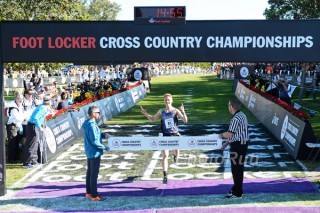
Balboa Park in San Diego was home to some of the top high school cross country runners in the U.S. on Saturday, as the Foot Locker Cross Country Championships took place at Morley Field.
The top 40 boys and top 40 girls competed, and Saturday’s race was a particular source of pride for the state of Virginia. Both winners—Drew Hunter of Purcellville and Weini Kelati of Leesburg—are from Loudoun County, giving the area immense bragging rights.
Hunter, who has committed to the University of Oregon, put together a dominant performance, winning by 12 seconds in a time of 14:55.7. Kelati, orginally from Eritrea, edged past MaryJeanne Gilbert to win 17:09.7, less than a second faster than Gilbert.
Here are photos from some of the standout performers, taken by PhotoRun.net:
Photo Gallery
1 of {count}
Back to Start
View Larger Image

The start of the boys race.
View Larger Image

Drew Hunter of Loudoun Valley High School in Purcellville, Va., was impressive throughout the race.
View Larger Image

Andrew Jordan of Watkins Memorial H.S., in Pataskala, Ohio, finished sixth in 15:16.6.
View Larger Image

The lead pack 400 meters in.
View Larger Image

Phillip Rocha of Arcadia High School in California finished second in 15:07.9.
View Larger Image

Ben Veatch of Carmel High School in Carmel, Ind., finished third in 15:09.6.
View Larger Image

Garek Bielazcyz of East High School in Salt Lake City finished fourth in 15:14.7.
View Larger Image

Paul Roberts of Lyons High School in Boulder, Colo., finished fifth in 15:15.6.
View Larger Image

The day belonged to Drew Hunter, who crossed the finish line in 14:55.7 to win by 12 seconds.
View Larger Image

Weini Kelati of Heritage High in Leesburg, Va., was among the lead pack throughout.
View Larger Image

McKenna Lee of Weber High in Pleasant View, Utah, was one of the few sophomores competing. She finished 17th in 18:09.2.
View Larger Image

MaryJeanne Gilbert of Notre Dame High in Peoria, Ill., was in contention throughout.
View Larger Image

The lead pack about two miles in.
View Larger Image

Libby Davidson of Glass High in Lynchburg, Va., finished sixth in 17:37.3.
View Larger Image

Nevada Mareno of Road High in Leesville, N.C., finished third in 17:17.6.
View Larger Image

The race was close to the finish.
View Larger Image

Judy Pendergast of North High in Naperville, Ill., finished fourth in 17:20.0.
View Larger Image

Madison Troy was the top sophomore in the field, finishing seventh in 17:41.2. She's from Grandville, Mich.
View Larger Image

Taylor Werner of Bloomsdale, Mo., finished fifth in 17:29.8.
View Larger Image

In the end, Weini Kelati held off MaryJeanne Gilbert to win in 17:09.7. Gilbert crossed in 17:10.6.
Related Galleries

Photos: 2014 Foot Locker Cross Country Championships

Barett, Fisher Win Foot Locker XC Champs

2009 Foot Locker Cross Country Championships Girls Photo Gallery

2009 Foot Locker Cross Country Championship Boys Photo Gallery

More Galleries
The post Photos: 2015 Foot Locker Cross Country Championships appeared first on Competitor.com.
December 13, 2015
Kenyans Sweep Honolulu Marathon in Ideal Racing Conditions
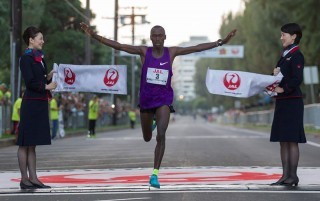
Filex Kiprotich winning the 2015 Honolulu Marathon in 2:11:43 (photo courtesy of the Honolulu Marathon Association)
(c) 2015 Race Results Weekly, all rights reserved. Used with permission.
HONOLULU — For the second consecutive year, Kenyans swept the wins here at the 43rd Honolulu Marathon. Taking advantage of excellent racing conditions—cool temperatures, no wind, and moderate humidity—Joyce Chepkirui and Filex Kiprotich attacked the course eyeing fast times and possible event records. Though they would fall short of the course records, both earned impressive wins in 2:28:34 and 2:11:43, respectively.
Chepkirui Defends Title, Earns Meaningful Win
As fireworks lit up the Hawaiian sky at Ala Moana Beach Park, Joyce Chepkirui got off to a blazing start. Leaving the pacemaker in their wake, Kenyans Chepkirui, Isabella Ochichi, and Lucy Karimi would roll through Waikiki well under course record pace, splitting an improbable 33:21 at 10K. Chepkirui thought a fast early tempo would play to her advantage.
Just before halfway, Chepkirui took the lead and slightly gapped her compatriots Ochichi and Karimi. Splitting the half-marathon in an eye-popping 1:11:43—believed to be the fastest half-way split in race history—Chepkirui was clicking off miles like a metronome. If she could keep this pace up, she would finish minutes under Lyubov Denisova’s event record of 2:27:19.
However, just like last year, the second half would slowly but surely catch up to Chepkirui. In the 18th mile (29th kilometer) Karimi and Ochichi came up on her shoulder, drawing even with the defending champion.
Overcoming the building fatigue, Chepkirui relied on sheer determination to complete the final miles: clear on her mind was here late manager Zane Branson, who passed away suddenly this past July at the age of 57. He was one of the first people to congratulate her after last year’s victory.
“I loved Zane, and Zane was like a brother,” said Chepkirui, who also won the Amsterdam Marathon last October. When asked if she dedicated today’s race to him, she responded with a firm, “Yes!”
Powering down Diamond Head Road with less than a mile remaining, Chepkirui broke away for good. She’d cross the finish first in 2:28:34 after running second half in a gritty 1:16:51.
“I won again and I feel happy. This was a great win today,” said Chepkirui, a medal and flower lei resting on her neck. “It was my plan, because on Wednesday I said I want to run 2:28 and I made it. I am so happy.”
Karimi finished second in 2:28:55, with Ochichi rounding out the top three in 2:29:44. The day, however, belonged to Chepkirui.
“By God’s will I’d like to come back again next year!” she said.
Kiprotich Runs Away With Men’s Title
In a word, Filex Kiprotich’s race could be described as calculated. The 27-year-old Kenyan played his cards perfectly, staying patient through the early stages before unleashing a surprising surge at 30 kilometers.
Through the half-marathon in 1:06:58 (much slower than the 1:05:30 organizers had requested from the pacemaker), all pre-race favorites were in contention: defending champion Wilson Chebet sat a meter off pacer Samuel Ndungu’s shoulder, while masters world record holder Kenneth Mungara and fellow Kenyan Kiprotich ran comfortably alongside. In all, a group of six were tightly bunched.
Ndungu stepped off the road at 30K (18.6 miles) as his pacing duties were complete, and the rest of the field grabbed their fluid bottles. Holding his bottle firmly, Kiprotich stepped on the gas pedal and spread the field thin, taking all by surprise with a quick surge. In the blink of an eye he held a 10-second lead.
Though Mungara came up on his shoulder a mile later, he simply could not keep pace with Kiprotich. Climbing up Diamond Head’s long hill from 37 to 40 kilometers, Kiprotich glanced back twice and saw no competitors. He continued to press unaware how close he was to James Muindi’s event record of 2:11:12.
“When I was at 30K I planned to break the course record so I decided to go,” said Kiprotich, smiling. “I kept going.”
In the end, Kiprotich would come up nearly a half minute shy of the record, breaking the finish tape in 2:11:43. Kiprotich’s margin of victory was a minute and three seconds over Chebet (2:12:46), while Daniel Limo finished third in 2:13:24.
“The weather was not bad but the course is too hard! When I was at 35 (kilometers), the course was difficult. There were a lot of hills,” he said.
Though disappointed not to retain his crown, Chebet gave credit to Kiprotich for maintaining the hard pace.
“When the eventual winner tried to push the pace, I was expecting that maybe he would not finish that pace. He was lucky because he tried to maintain his pace and I tried my best to follow,” said Chebet, who added that with nine kilometers left he believed he could catch Kiprotich. “I congratulate him for the win.”
In addition to the $40,000 winner’s check (same as Chepkirui in the women’s race), Kiprotich will take home $10,000 in time bonus incentives.
A total of 30,783 athletes entered the 43rd Honolulu Marathon. With no time limit to complete the course, competitors came through the Kapiolani Park finish line throughout the day.
The post Kenyans Sweep Honolulu Marathon in Ideal Racing Conditions appeared first on Competitor.com.
Galen Rupp Runs 1:01:20 Half Marathon…What’s Next?
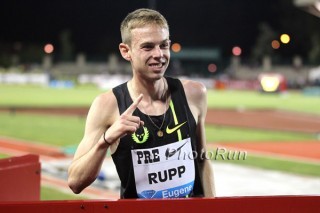
Photo: PhotoRun.net
U.S. distance running star Galen Rupp won the Foot Traffic Holiday Half Marathon in Portland on Sunday, clocking a time of 1 hour, 1 minute and 20 seconds to win the small race by more than 10 minutes. It was his first half marathon in more than four years.
More importantly, his time was easily fast enough to qualify for the 2016 U.S. Olympic Trials marathon (which has a 1:05 half marathon qualifying standard for men). Whether or not he’s going to run the Feb. 13 marathon in Los Angeles remains to be seen, but his performance on Sunday was set up to give him the opportunity if he chooses to pursue it. It would be his marathon debut.
“I’m keeping my options open,” Rupp told the Oregonian after Sunday’s race.
Rupp would be among the favorites to make the Olympic team in the marathon if he chooses to go for it. If Rupp were to make the 2016 U.S. Olympic team in the marathon, he could attempt to double in the 10,000-meter run at the U.S. Olympic Trials on the track in early July. The Olympic 10,000-meter final is scheduled for Aug. 13, eight days before the marathon.
Sunday’s Holiday Half Marathon was Rupp’s second half—in 2011, he ran a 1:00:30 at the NYC Half. He ended up sticking exclusively to the track for the following year’s London Olympics, and it paid off—he won silver in the 10,000m, finishing behind only training partner Mo Farah of Great Britain.
Rupp’s 2016 plans will be an interesting storyline in running over the next couple of months.
Rupp has won seven straight U.S. titles in the 10,000m and has finished eighth or higher at the world championships and Olympics five times since 2009. He also has four top-10 international finishes in the 5,000m, including a seventh-place showing at the 2012 Olympics.
The post Galen Rupp Runs 1:01:20 Half Marathon…What’s Next? appeared first on Competitor.com.
December 11, 2015
An Excerpt from Coach Brad Hudson’s Little Black Book
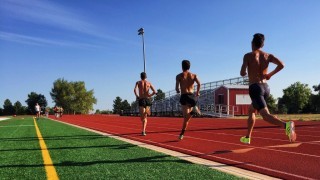
Hudson's elite athletes training on the track in Boulder, Colo. Photo: Mario Fraioli
When starting this book, I asked myself, “What’s the book I’d want as a new coach?” This is it.
Coach Hudson’s Little Black Book is not a training book; it’s a collection of workouts compiled over years of working with athletes of varying ability levels with information on the how and the why of each training session.
This book—which will be limited to 200 copies—is perfect for any serious coach, or self-coached athlete (especially for elites or sub-elites, but also for dedicated age-groupers), and at 5.5 x 8.5 inches, it easily fits in your track bag or big pocket. And there’s plenty of room for personalized notes within the margins.
What follows is an excerpt from the 5,000m chapter of the book, including a listing of the workouts you’ll find in this section along with examples of late-race prep workouts that can be done in the latter stages of a training cycle.
RELATED: Last Lap with Brad Hudson, The Marathon Whisperer
5,000m Workouts
“One thing about racing is that it hurts. You better accept that from the beginning or you’re not going anywhere.” — Bob Kennedy
Workouts in this Section:
— 400m Repeats
— Bread and Butter
— Mechanical Speed
— Pace-Changers
— Cut-Down Ladders
— Race Spec + Fast Quarters
— Spec with Maximal Hills
— The Bill Dellinger
– Broken Race Simulators
— Gear Changers
— Late Race Prep
— Pre-Race
To me, the 5,000m should be the most exciting event in T&F. To be a great 5,000m runner, you not only have to have tremendous speed and tremendous endurance, but also a tremendous psychological capacity to feel pain. A lot of my Oregon coaches used to talk about callusing. That’s what I think about the 5,000m. You have to be able to run close to race pace in workouts, time after time after time, so you can have the endurance that you can maintain for your race.
So not only is the 5,000m is an event where you need great speed, great running economy, and great fatigue resistance, but you need the ability to keep that mental strength throughout the 12.5 laps on race day, and throughout the many, many more laps beforehand.
Let’s take a look at examples of late-race prep workouts:
— 3 x 2,000m, 3-4min recovery
— 2 x mile, 8 minutes recovery. First at race pace, second time-trial
— 3 x 2,000m alternating laps, 6 minutes recovery
— 3 x 1,600m alternating laps, 5 minutes recovery
• All to be done late in the season when already very fit and ready for goal races.
• 3×2,000m at RP can be race replacement; it’s very hard to run 6K at ~goal 5K pace.
• Alternating workouts are great for tactical prep especially ahead of championships.
• Start on fast lap; pace is ~3K and float is ~10K/threshold pace.
• Dathan Ritzenhein did middle two prior to 3rd at 5,000m at 2006 USA Champs.
• He hit 61-64 for the fast and 70-72 for the float in that 2,000m workout.
• For the 2 x 1-mile workout he hit 4:08 then 4:01.
• Idea is to put in some fatigue with a mile at 5,000m pace before going all-out.
• Goal was to get ready to push from a mile out, which is roughly what happened.
• 2 x mile workout can also work as a replacement for a 1,500m tune-up race.
The post An Excerpt from Coach Brad Hudson’s Little Black Book appeared first on Competitor.com.
Famous & Fast: 33 Celebs and Notables Names Who Have Run a Marathon 3:30 Or Faster
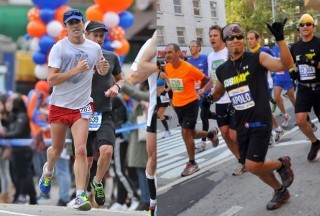
Magician and mentalist Oz Pearlman owns a 2:23 marathon PR, while former Olympic speedskater Apolo Ohno has run a 3:25.
When it comes to running 26.2 miles, celebrities and notable personalities are just like the rest of us. They have to train to get to the finish line, especially to run a fast time. Here are 33 notable personalities who have run a marathon faster than 3:30.
RELATED: 36 Celebrities (and Other Notable People) Who Run
Oz Pearlman, mentalist and magician, 2:23:52, 2014, Philadelphia Marathon
Daniel Atienza, former pro cyclist, 2:29:27, 2013 Zurich Marathon
Matthew Parris, former member of British Parliment, 2:32:57, 1985, London Marathon
Wolfgang Ketterle, Nobel Prize-winning physicist, 2:44:06, 2014, Boston Marathon
Lance Armstrong, former pro cyclist, 2:46:43, 2007 New York City Marathon
James Cracknell, Olympic rower, 2:50:43, 2015, London Marathon
David Petraeus, former CIA Director, 2:50:53, 1982, Omaha Marathon
Jenson Button, Formula One driver, 2:52:30, 2015, London Marathon
Nell McAndrew, model, 2:54:39, 2012, London Marathon
Erich Segal, writer, 2:56:30, 1964, Boston Marathon
Mikuláš Dzurinda, former prime minister of Slovakia, 2:54:57, 1986, Malokarpatsky Marathon
Guido van der Werve, Dutch artist/filmmaker, 2:57:06, 2013 Berlin Marathon
Stuart Murdoch, musician (Belle & Sebastian), 2:57:08, 1986 Glasgow Marathon
Benjamin Cheever, writer, 2:58:35, 1981, New York City Marathon
John Keston, actor, 3:00:58, 1996 Twin Cities Marathon
Max Baucus, former U.S. Senator, 3:01:18, 1982 Governor’s Cup Marathon
Johnny Lee Miller, actor, 3:01:40, 2013, New York City Marathon
Dana Carvey, actor/comedian, 3:04:21, 1972, Ocean to Bay Marathon
Peter Sagal, radio personality, 3:09:25, 2011, Philadelphia Marathon
Clarence Thomas, U.S. Supreme Court Justice, 3:11:00, 1980 Marine Corps Marathon
Ed Viesturs, mountain climber, 3:15:18, 2006, New York City Marathon
Harry Reid, U.S. Senator, 3:16.0, 1972, Boston Marathon
Andy Baldwin, reality TV personality, 3:17:31, 2011, New York City Marathon
Ryan Sutter, reality TV personality, 3:17:56, 2011, New York City Marathon
Bryan Cranston, actor, 3:20:45, 1985, New York City Marathon
Bjorn Ulvaeus, musician (ABBA), 3:23:54, 1980, Stockholm Marathon
Mike Malinin, musician (Goo Goo Dolls), 3:23:56, 2000, San Francisco Marathon
Billy Baldwin, actor, 3:24:29, 1992, New York City Marathon
Apolo Ohno, Olympic speedskater, 3:25:12, 2011, New York City Marathon
Caroline Wozniacki, professional tennis player, 3:26:23, 2014 New York City Marathon
Anna Kooiman, TV news personality, 3:27:22, 2008, Glass City Marathon
Kimiko Date-Krumm, former professional tennis player, 3:27:47, 2004, London Marathon
Tom Cavanagh, actor, 3:29:31, 2006, New York City Marathon
RELATED: TV’s Mentalist Oz Pearlman Runs 2015 NYC Marathon in 2:31:04.
The post appeared first on Competitor.com.
Book Review: Ed Caesar’s ‘Two Hours’
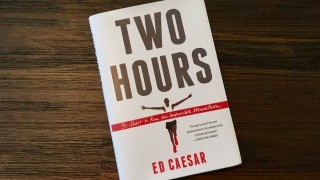
In 2011, I stood in the Boston Marathon media room at the Fairmont Copley Plaza hotel with dozens of other members of the media, watching two lithe Kenyans run at breakneck speed down Boylston Street on the big screen in front of us. One of those runners, Geoffrey Mutai, went on to win the race in a shade over 2 hours and 3 minutes, turning more than a few heads in the room while instantaneously redefining what might be possible over 26.2 miles of racing.
While Mutai’s time of 2:03:02 could not be considered a world record due to the point-to-point downhill nature of Boston’s iconic course, it reignited talk of the 2-hour marathon—the 4-minute mile of road racing—and whether or not we would see such a mark in our lifetimes.
By now, four-plus years after Mutai’s eye-popping performance in Boston, only one runner—Mutai’s Kenyan training partner Dennis Kimetto—has run faster, recording the current world record of 2:02:57 in 2014 at the Berlin Marathon. There’s still a long way to go.
So you can imagine my excitement when I recently received my copy of Ed Caesar’s new book, Two Hours, which coincidentally opens at the 2012 Berlin Marathon, where Mutai was embarking on an annihilation of Patrick Makau’s then world-record of 2:03:38. While Mutai won the race that day—virtually alongside Kimetto, no less—he came up far short of a world record, running 2:04:15, the fastest time of the year, but a performance that Caesar describes as “a sense of opportunity lost—a tide untaken” for Mutai.
RELATED: The Evolution of the Marathon’s Fastest Men
Two Hours is an interweaving of many elements related to the sport of marathoning that all tie into the seemingly impossible quest to take down the sport’s most vaunted barrier—along with a discussion of exactly what conditions would need to exist for such a performance to take place. It’s mostly a compelling narrative of Mutai’s ascendance from poor farmhand into the world’s most dominating marathoner, but it’s also part marathon history lesson, part discussion of physiology, geography and culture, and part commentary on the current challenges the sport faces, including the economics of modern day marathoning and the problem of doping in Kenya.
One of the most interesting—and refreshing—aspects of this book is that Caesar is not an athletics writer by trade, and I think that helps provide an unbiased perspective into the current state of the sport and how it’s viewed by someone outside of its inner circle. Caesar spent a considerable amount of time in Kenya with Mutai and his training partners trying to understand why a majority of the world’s best marathoners come from the tiny Kalenjin tribe, along with taking a deep dive into uncovering their their history, physiology, motivations and training methods. He also traveled to races around the world and witnessed first-hand these savage attempts on the lowering of time. In short, Caesar did his homework, and the result is one of best books about running ever written (and I’ve read many of them). This holistic view of the sport of marathoning, combined with the story of how one man—Mutai—fits into its overall history while chasing its unassailable holy grail, is one of the finest examples of non-fiction storytelling that I’ve read in quite some time. Put it on your holiday gift list.
RELATED: The 25 Greatest Running Books of All-Time
The post Book Review: Ed Caesar’s ‘Two Hours’ appeared first on Competitor.com.
Honolulu Marathon a Popular Choice for First-Timers
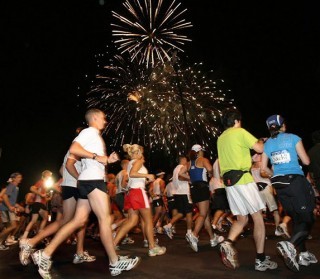
The fireworks at the start of the 2014 Honolulu Marathon (photo by Ronen Zilberman for the Honolulu Marathon)
(c) 2015 Race Results Weekly, all rights reserved. Used with permission.
HONOLULU — More than 30,000 athletes have signed up for Sunday’s 43rd Honolulu Marathon, which begins with a spectacular fireworks show over Ala Moana Beach Park. Among the crowd gathered, roughly 37 percent of runners will be racing the marathon distance for the first time—a hefty percentage of marathon newbies who are drawn to this event for different reasons.
Of the 1,200-plus marathons held annually in the United States, thousands of athletes routinely travel here to commence their marathon careers, racing 26.2 miles for the first time. Speaking to athletes at the Honolulu Marathon Expo, this reporter heard a variety of reasons as to why they chose to race the challenging route from Ala Moana Beach Park, along Waikiki Beach, up and down Diamond Head crater before finishing in Kapiolani Park.
The rational for choosing Honolulu as a first marathon is both tradition and a bit off-the-wall. One of the more popular reasons is its location and date. Along one of the most scenic and picturesque stretches, the race route showcases many of Honolulu’s iconic destinations and natural beauty. Held in December, it makes a nice getaway for those living in the continental United States or elsewhere.
Beyond that, the draw of no time limit makes the event accessible to athletes ranging from elite Olympians to walkers. There is no cut-off, and organizers pride themselves on giving all athletes the chance to complete the course in however long its takes. According to Running USA’s most recent marathon report (covering the year 2014), Honolulu had the most finishers aged 60 or above (3,326 in 2014). Looking back an additional year to 2013, the Honolulu Marathon had the second-slowest median time (6:07:32) and the most 6-plus hour finishes (10,032, or 45 percent of finishers).
Of course, the unique finisher medals and delicious malasada treats waiting at the finish are always a big draw, too.
RELATED: 15 Bucket-List Marathons in the United States
At the Honolulu Marathon Expo, Race Results Weekly caught up with a few individuals who explained why they chose to race the Honolulu Marathon for the first time. The answers ranged in depth and detail, but gave a glimpse into what the race is all about: unique journeys to the start line.
The most intriguing story came from Patrick Mansfield, a native of England. Sitting in a pub back home, Mansfield made a bet with a friend that he’d come to Honolulu to do the marathon at the age of 72, proving he was healthy. That was more than a decade ago.
“I just came and I thought it would be easy,” he said, shaking his head. “I didn’t put any Vaseline on, didn’t do any of those [running] things, and it was the hardest day of my life! Truly, it was the hardest day of my life. I was in the Royal Air Force as a young man and did militant training, but that day was the hardest.”
By the time Mansfield reached 35 kilometers (or 21.75 miles), he was shaking, crying, and close to collapsing. All he could do to muster strength to finish was recite classic Winston Churchill speeches.
“It taught me a lesson, and then I decided to train and I’ve done it for the last 10 years. Nothing in my life will ever compare to that first year,” he said. “The shower after the marathon is the best shower you’ve ever had, the beer you have afterwards is the best beer you’ve ever had.”
Mansfield may have chosen to run the Honolulu Marathon for the first time as part of a bet. But it turned into a life lesson he’d cherish to this day.
“By doing the marathon I realized how easy our life is. Once a year I realize, really realize, how deep you have to go to finish, and how lucky my life is,” Mansfield said.
Speaking to other entrants, many have chosen Honolulu because it is such a community event on the island. No matter a runner’s ability, at one point or another participants get swept up by the marathon bug. Organizers also offer special discounts to runners—particularly locals—including walk-up registration at the Expo.
“I live here and this is our local race,” said Thomas Risse of Honolulu. “I’ve done five or six Honolulu Marathons now. The best part is the start and the fireworks, running through Chinatown and by City Hall all lit up. This one is my hometown race, and that’s why I started. But what differentiates it is that a lot of people who aren’t necessarily runners come out and run it or spectate. It brings a lot to our state, and is a lot different from mainland marathons. That’s why people run it and start running it. It’s a celebration.”
Fellow Honolulu resident Angela Tseng agreed.
“This will be my first time. I chose it because I live here and everyone gets excited for it and looks forward to it,” she said. “I have run in other cities, but I’m definitely looking forward to this. I look forward to the atmosphere and crowd, and experiencing the city in a different way.”
Of the athletes RRW spoke to, Brazil’s Andreia Henssler had perhaps the most interesting story. Sunday’s race will be her first marathon in North America. But more importantly, it will help her achieve a goal of running a marathon on all seven continents (including Antarctica).
“I chose it because I have a project for myself to run on all continents of the world, all seven continents,” she said with a smile. “This is my last continent.”
From Porto Alegre, Henssler summed up why most visitors wind up running the Honolulu Marathon.
“I chose Honolulu because Hawaii is very beautiful and it is very special. It is my dream to come and race here,” she said.
RELATED: 88-Year-Old Marathoner Keeps on Running
The post Honolulu Marathon a Popular Choice for First-Timers appeared first on Competitor.com.
USA Track & Field Amends Olympic Trials Marathon Qualifying Standards
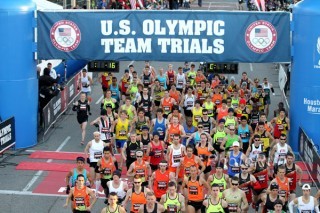
Photo: PhotoRun.net
A day following the IAAF’s decision to loosen the qualifying standards for 17 events on the Athletics program for next summer’s Olympic Games in Rio—including the marathon—USA Track & Field has followed suit, lowering the “B” qualifying standards for February’s Olympic Trials Marathon on Feb. 13 in Los Angeles, to sub-2:45:00 for women and sub-2:19:00 for men.
“The aim is to have more athletes achieving the standard and therefore, to get closer to the target number of participants,” the IAAF said on Thursday.
Friday’s changes mean that U.S. athletes who fell short of the previously listed minimum standards of 2:43 for women and 2:18 for men—the qualifying window opened on August 1, 2013 and closes on January 17, 2016—can now enter the race.
The relaxed standards likely means dozens of more runners will be eligible for the Trials marathon. Newly qualified runners intending to enter can do so on the USATF website.
As of this Dec. 8, USATF lists 73 men and 157 women as having achieved the previous minimum qualifying standards in the marathon, and an additional 97 men and 38 women through their half marathon time (1:05 for men and 1:15 for women, which remains unchanged).
RELATED: Sizing Up 2016: Who will make the U.S. Olympic Marathon Team?
The post USA Track & Field Amends Olympic Trials Marathon Qualifying Standards appeared first on Competitor.com.
Funny Friday: How To Be An Ultrarunner
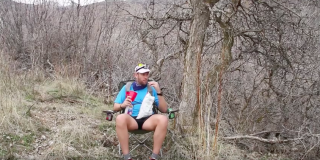
Want to be an ultra runner? Apply these critical and humorous techniques to become a full-fledged long-distance trail fiend!
The post Funny Friday: How To Be An Ultrarunner appeared first on Competitor.com.
How To Get Into the 2016 New York City Marathon
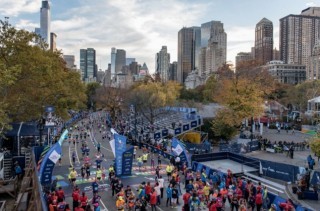
More than 50,000 runners will be accepted into the 2016 New York City Marathon, but there are only five ways to get into the race. Photo: Matt Trappe
The New York City Marathon is a world-class event and should be on the proverbial bucket list of every runner, no matter if you’re a super-fast sub-elite runner, a dedicated middle-of-the-pack runner or a new runner who might only run a few marathons in your lifetime. But, given how hard it is to get into the race, running the iconic five-borough race is much easier said than done.
More than 50,000 people will be accepted to run in next year’s race on Nov. 6 and here are the five ways to get in:
Enter the Sweepstakes
Enter the 2016 TCS New York City Marathon Sweepstakes. There are 100 guaranteed, non‐complimentary spots in next year’s race. The deadline to enter is and winners will be informed on or before January 13.
Enter the Drawing
You can also enter the marathon’s general drawing. The application opens Jan, 21 and runs through 11:59 p.m. EST on Feb. 21. Applicants must be 18 years of age or older on Nov. 6 to be eligible. Runners will be selected via three drawings. Last year, less than 20 percent of those entered in the drawing got into the race. But it’s worth a chance.
Run for a Charity or Kids
Guaranteed entries are also available by running for one of the official New York City Marathon charity partners or by running with the NYRR Team for Kids. Charity partner details will be announced in the spring, but you can sign up to run with NYRR Team for Kids today and get a guaranteed spot. In either case, you’ll have to commit to raising money to earn your spot in the race
Run a Qualifying Time
Although not as comprehensive as the Boston Marathon, the New York City Marathon also has a qualifying program for runners who are fast enough to make the time standards (from an approved half marathon or marathon). But fewer runners are accepted by time qualifiers and the the New York City Marathon time standards are much faster than Boston’s qualifying times. For example, the qualifying time needed for the New York City Marathon for the men’s 35-39 age group is 2:55:00, compared to 3:10 for the same age-group in Boston. For women, New York City Marathon requires a 3:15:00, whereas Boston requires a 3:40.
The qualifying window for the 2016 race is Jan. 1 to Dec. 31, 2015. All runners who made ran faster than the time standards in the 2015 New York City Marathon or in an New York Road Runners half‐marathon are eligible for guaranteed entry. The remaining spots will be filled on a first‐come, first‐served basis until the cap, which is to be determined, has been reached.
Join an International Marathon Tour Group
For runners who live outside of the U.S., guaranteed entries are available through an International Travel Partner (ITP). The race entries are contingent upon purchasing a marathon travel package that includes a flight into a New York City-area airport and/or a hotel stay in New York City.
RELATED: New Balance, NYRR Sign Huge Sponsorship Deal
The post How To Get Into the 2016 New York City Marathon appeared first on Competitor.com.
Ryan Hall's Blog
- Ryan Hall's profile
- 21 followers



